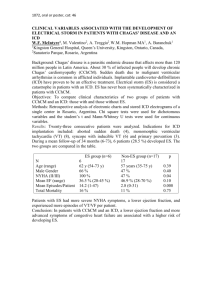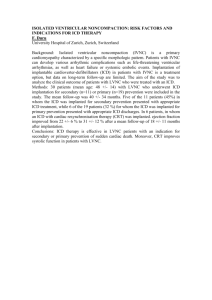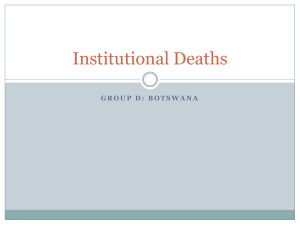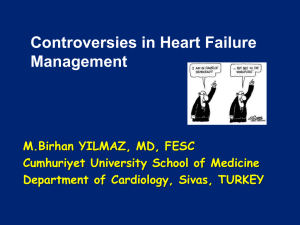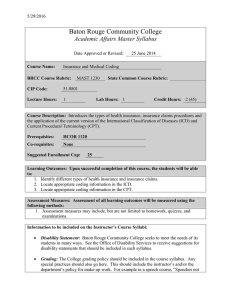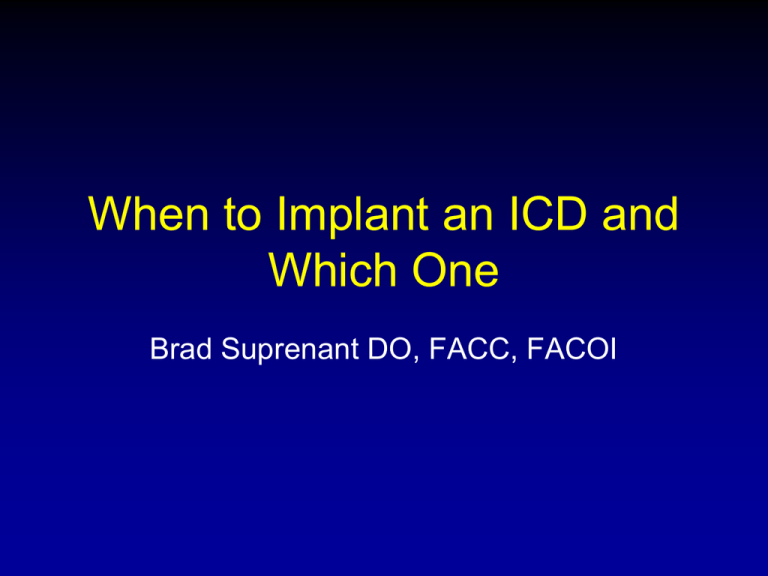
When to Implant an ICD and
Which One
Brad Suprenant DO, FACC, FACOI
Major Implantable Cardioverter-Defibrillator
Trials for Secondary Prevention of Sudden
Cardiac Death
Trial
Year
Patients
(n)
Inclusion
Criterion:
LVEF
Additional Study
Features
Hazard
Ratio*
95% CI
p
AVID
1997
1016
< 40%
Prior cardiac Arrest,
or Unstable VT
0.62
(0.43-0.82)
p<0.02
CASH†
2000
191
Mean <
45% ±18 at
baseline
Prior cardiac arrest
0.766
‡
p=0.08
CIDS
2000
659
< 35%
Prior cardiac Arrest,
Unstable VT, or
Syncope
0.82
(0.60-1.1)
NS
Major Implantable Cardioverter-Defibrillator
Trials for Primary Prevention of Sudden
Cardiac Death
Trial
Year
Patients
(n)
Inclusion
Criterion:
LVEF
Additional Study
Features
Hazard
Ratio*
95% CI
p
MADIT I
1996
196
< 35%
NSVT and EP+
0.46
(0.26-0.82)
p=0.009
MADIT II
2002
1232
< 30%
Prior MI
0.69
(0.51-0.93)
p=0.016
CABG-Patch
1997
900
< 36%
+SAECG and CABG
1.07
(0.81-1.42)
p=0.64
DEFINITE
2004
485
< 36%
NICM, PVCs or NSVT
0.65
(0.40-1.06)
p=0.08
DINAMIT
2004
674
< 35%
6-40 days post-MI
and Impaired HRV
1.08
(0.76-1.55)
p=0.66
SCD-HeFT
2006
1676
< 35%
Prior MI or NICM
0.77
(0.62-0.96)
p=0.007
Guidelines
Current ACC/AHA/HRS guidelines for ICD
and CRT implant from 2008
ICD
• Class I
– VT/VF survivors with irreversible etiology
– sustained VT with structural heart disease
– syncope + VT/VF at EPS
– NYHA II-III, LV EF<35%
– NYHA I, post-MI, LV EF<30%
– NSVT, post-MI, LV EF<40%, VT/VF at EPS
ICD
ICD
• Class IIa
– syncope, LV dysfunction, non-ischemic DCM
– Sustained VT
– HCM with major risk factors
– ARVD with major risk factors
– LQTS with syncope while on BB therapy
– transplant bridge
– Brugada syndrome with syncope or VT
– Catecholaminergic polymorphic VT with syncope
ICD
ICD
• Class IIb
– NYHA I, LV EF<35%
– LQTS and SCD risk factors
– idiopathic syncope and advanced SHD
– familial CMP
– LV noncompaction
ICD
ICD
• Class III
– expected survival less than 1 year (other cause)
– incessant VT/VF
– significant psychiatric illness
– NYHA IV without transplant or CRT indication
– idiopathic syncope with no inducible VT/VF and SHD
– VT/VF amenable with ablation
– VT/VF with reversible cause
ICD
Notable Changes in 2008 ACC/AHA/HRS Guidelines
1. ICD recommendations are combined into a single list because of
overlap between primary and secondary indications.
2. Primary prevention ICD indications in nonischemic cardiomyopathy are
clarified using data from SCD-HeFT (i.e., ischemic and nonischemic
cardiomyopathies and LVEF ≤35%, NYHA II-III) for support.
3. Indications for ICD therapy in inherited arrhythmia syndromes and
selected nonischemic cardiomyopathies are listed.
4. MADIT II indication (i.e., ischemic cardiomypathy and LVEF ≤30%,
NYHA I) is now Class I, elevated from Class IIa.
5. EF criteria for primary prevention ICD indications are based on entry
criteria for trials on which the recommendations are based.
Notable Changes in 2008 ACC/AHA/HRS Guidelines
6. The need for optimization of medical therapy before CRT implantation is
emphasized.
7. Independent risk assessment preceding ICD implantation is emphasized,
including consideration of patient preference.
8. Optimization of pacemaker programming to minimize unneeded RV
pacing is encouraged.
9. A section has been added that addresses ICD and pacemaker
programming at end of life.
10. Emphasized primary SCD prevention ICD recommendations apply only to
patients
receiving optimal medical therapy and reasonable expectation of survival
with good functional capacity for >1 year.
Key Timing Issues from Guidelines
• Ensure proper time periods since
diagnosis or treatment
– Must be > 40 day since MI
– Must be > 3 months since revascularization
– Must be > 3 months since diagnosis of CHF
• On optimal HF medical treatment
CRT
• Class I
– LV EF<35%, QRS>120ms, NYHA III-IV, SR
• Class IIa
– LV EF<35%, QRS>120ms, NYHA III-IV, AF
– LV EF<35%, NYHA III-IV, VP dependent
• Class IIb
– LV EF<35%, NYHA I-II, VP% high
• Class III
– reduced LV EF only
– limited life expectancy (non-cardiac)
CRT
Trials have Proven CRT Safety and
Efficacy
ACC/AHA/HRS Class I Indication:
OPT, EF ≤ 35%, QRS ≥ 120ms, and NYHA Class III-IV*
MIRACLE
4000
3500
NEJM; 2002
CONTAK-CD
JACC; 2003
MIRACLE ICD
JAMA; 2003
COMPANION
NEJM; 2004
CARE-HF
NEJM; 2005
RHYTHM ICD
Heart Rhythm; 2005
n=205
Total enrolled patients = nearly 4,000!
n=813
3000
2500
n=1520
2000
1500
n=420
1000
n=490
500
n=453
0
*Level of Evidence:"A”
13
The Role of CRT in Earlier Stages of Heart
Failure
Recent CRT trials have examined the effect of CRT in
patients with asymptomatic and mild heart failure (NYHA
Classes I and II )
These include:
•MADIT-CRT1
•REVERSE2
•RAFT3
1Moss
AJ, Brown MW, Cannom DS, et al. Multicenter Automatic Defibrillator Implantation Trial-Cardiac
Resynchronization Therapy (MADIT-CRT): Design and Clinical Protocol. Ann Noninvasive Electrocardiol
2005;10:Suppl:34-43
2Linde C, Gold M, Abraham WT, et al. The REsynchronization reVErses Remodeling in Systolic left vEntricular
dysfunction (REVERSE) study. Am Heart J 2006;151:288-94.
3Tang AS, Wells GA, Arnold M, et al. Resynchronization/defibrillation for ambulatory heart failure trial (RAFT): rationale
and trial design. Current Opinion in Cardiology 2009;24:1-8
14
Similar Results for CRT in Patients
with Mild Symptoms
Death or Heart Failure Hospitalization
Hazard Ratio with 95% CI
0.49
REVERSE
p = 0.004
0.73
p = 0.001
RAFT NYHA II
0.66
MADIT CRT
0.1
P < 0.001
CRT-D Better
REVERSE: Linde C, et al. JACC. 2008;52:1834-1843.
RAFT: Tang A, et al. N Engl J Med. 2010;363: 2385-2395.
MADIT-CRT: Moss A, et al. N Engl J Med. 2009;361:1329-1338.
1
10
Totality of Evidence: Conclusion
In the expanded indication patient
population, CRT-D:
• Reduces mortality
• Reduces heart failure hospitalization
• Improves cardiac function
16
NCDR ICD Registry
• The National Cardiovascular Data Registry
for ICDs
– CMS mandated
– 78% of centers report on all ICD implants not
just the ones covered by CMS
Methods
• Patients were classified as receiving a nonevidence-based implant if they had:
•
•
•
•
MI within 40 days
CABG within 90 days
CHF NYHA Class IV without CRT
CHF diagnosed within 90 days
Al Khatib et al., JAMA 2011;305(1):43-49
‘Non-Evidence-Based’ ICD
Implantations
• NCDR ICD registry based study [Al Khatib et al.,
JAMA 2011;305(1):43-49]
– 22.5% of primary prevention implants were ‘nonevidence-based’
• higher risk of in-hospital mortality/post-procedural
complications
• substantial hospital variation (0-60%)
• Not reducing over time
• Provocative and controversial issue
– Arguments: Data limitations, criteria interpretations,
clinical appropriateness, semantics, etc.
• Department of Justice audits [Steinberg and Mittal, JACC
2012;59:1270-1274]
Conclusions
• A substantial number of ICDs are being
implanted in patients who were either excluded
from the major clinical trials of primary
prevention ICDs or proven not to benefit from
ICD therapy in other trials.
• Such patients are not only sicker than patients
receiving an evidence-based-device, but they
are at a higher risk of in-hospital death and any
post-procedure complication.
Conclusions
• More efforts should focus
on enhancing adherence to
evidence-based practice.
Patient Case Study 1
• Following a 67 year old female with nonischemic cardiomypathy, Class II HF, and
a LVEF of 30%. Diagnosed with HF 2
years ago and continues to be mildly
symptomatic despite optimized medical
therapy. No history of SCA or sustained
VT.
• Should an ICD be considered for this
patient?
Patient Case Study 1
• Yes
– Primary prevention of VT/VF
• Which type of ICD?
– Single Chamber
– Dual Chamber
– Triple Chamber (CRT-D)
• Does Patient have LBBB with QRS >
130ms?
Patient Case Study 1
• If no LBBB with QRS > 130ms
– Dual chamber if bradycardia pacing indication
– Single chamber otherwise
• If yes to LBBB with QRS > 130ms
– Consider CRT-D
• New evidence of benefit in these patients
with CRT-D
– FDA approved use*
– Guidelines written prior to this
*Medtronic and Boston Scientific have FDA approved labeling for use of their Bi-V ICDs in these patients.
Patient Case Study 2
• 55 year old male with ESRD successfully
resuscitated from SCA. Non-ischemic DCM with
LVEF=38%, NYHA Class II systolic/diastolic HF
with sinus rate 90 bpm and QRS duration=
100msec.
Implant ICD?
Which one?
Patient Case Study 3
• 65 year old male in sinus rhythm with three
vessel CAD, moderate-severe AS, and
LVEF=20%. Post-op patient develops CHB that
requires a PPM.
Implant AVPPM ?
Implant CRT-P ?
Implant CRT-D ?
Sub-Q ICD
Thank You
Questions?
Comparison of Medical Therapy, Pacing,
and Defibrillation in Heart Failure
(COMPANION) Trial
• 1520 patients with NYHA Class III or IV HF, ischemic
cardiomyopathy (ICM) or nonischemic cardiomyopathy
(NICM) and QRS of at least 120 ms
• Randomized 1:2:2 to optimal pharmacological therapy
(OPT) alone or in combination with cardiac
resynchronization therapy with either a pacemaker (CRTP) or pacemaker-defibrillator (CRT-D)
• Both device arms significantly ↓ combined risk of all-cause
hospitalization and all-cause mortality by ~20% compared
with OPT
• CRT-D ↓ mortality by 36% compared with OPT (p=0.003)
• Insufficient evidence to conclude that CRT-P inferior to
CRT-D
Bristow MR, Saxon LA, Boehmer J, et al. Cardiac-resynchronization therapy with or without an implantable defibrillator in advanced
chronic heart failure. N Engl J Med 2004;350:2140-50.
Multicenter Automatic Defibrillator
Implantation Trial II (MADIT II)
• 1232 patients ≥ 1 month post-MI and LVEF ≤ 30%
• Randomized to ICD (n=742) or medical therapy (n=490)
• No spontaneous or induced arrhythmia required for
enrollment
• 6% absolute and 31% relative risk ↓ in all-cause mortality
with ICD therapy (p=0.016)
Moss AJ, Zareba W, Hall WJ, et al. Prophylactic implantation of a defibrillator in patients with myocardial infarction and reduced
ejection fraction. N Engl J Med 2002;346:877-83.
Sudden Death in Heart Failure
(SCD-HeFT) Trial
• 2521 patients with NYHA Class II or III HF, ICM, or
NICM and LVEF ≤ 35%
• Randomized to
1) conventional rx for HF + placebo;
2) conventional rx + amiodarone; or
3) conventional rx + conservatively programmed shockonly single lead ICD
• No survival benefit for amiodarone
• 23% ↓ in overall mortality with ICD therapy
• Absolute ↓ in mortality of 7.2% after 5 y in the overall
population
Bardy GH, Lee KL, Mark DB, et al. Amiodarone or an implantable cardioverter-defibrillator for congestive heart failure. N Engl J Med
2005;352:225-37.
Defibrillator in Acute Myocardial
Infarction (DINAMIT) Trial
• 674 patients 6 to 40 days post-MI with LVEF ≤ 35% and
impaired cardiac autonomic function
• Randomized to ICD therapy (n=332) or no ICD therapy
(n=342)
• Arrhythmic death ↓ in ICD group, but ↑ in nonarrhythmic
death (6.1% per year vs. 3.5% per year, HR 1.75 (95%
CI 1.11 to 2.76; p=0.016)
• No difference in total mortality
Hohnloser SH, Kuck KH, Dorian P, et al. Prophylactic use of an implantable cardioverter-defibrillator after acute myocardial
infarction. N Engl J Med 2004;351:2481-8.
Defibrillators in Nonischemic Cardiomyopathy
Treatment Evaluation (DEFINITE) Trial
• 458 patients with NYHA Class I to III, NICM, LVEF ≤
36% and premature ventricular contractions (> 10/h) or
NSVT
• Randomized to standard medical rx alone or in
combination with single-chamber ICD
• Strong trend toward ↓ all-cause mortality with ICD
therapy, although not statistically significant (p=0.08)
Kadish A, Dyer A, Daubert JP, et al. Prophylactic defibrillator implantation in patients with nonischemic dilated cardiomyopathy. N Engl J
Med 2004;350:2151-8.
Achieving Cardiac
Resynchronization
• Improved
Contraction
Pattern
– Organized
ventricular
activation
sequence
Courtesy of Ottawa Heart Institute
Achieving Cardiac
Resynchronization
• Optimized AV
Interval
– Reduced mitral
regurgitation 1,2,3
1 Nishimura
et al.
et al.
3 Brecker et al.
2 Etienne
Overview of Primary Prevention
Trials
Trial
MADIT
MUSTT
MADIT II
Results
54% reduction in mortality with ICD
55-60% reduction in mortality with
ICD
31% reduction in mortality with ICD
DEFINITE Mortality benefit 5.7% at 2 years
with ICD
SCDHeFT 23% reduction in mortality with ICD
SCD and ICD Summary
• SCD – THE leading cause of death in the US
• ICDs superior to optimal medical mgmt alone
as demonstrated in multiple clinical trials
• Patients at risk need to be identified before
they have SCD
–KNOW YOUR PATIENT’S EF !!!!
• ICDs are cost-effective and underutilized
• ICD therapy can be painless
• The mortality risk of NOT having an ICD far
outweighs the risk of device failure
SCD-HeFT Versus Other Landmark
Device Trials in Heart Failure
28.8%
30.0%
Control
Therapy
P=0.007
% Mortality
25.0%
22.0%
19.8%
19.0%
20.0%
P=0.016
P=0.004
14.2%
15.0%
12.0%
14.1%
P=0.065
7.9%
10.0%
5.0%
0.0%
MADIT II
HF Etiology
NYHA Class
LVEF
No. Pts
Follow-Up
Hazard Ratio
Ischemic: 100%
COMPANION
Ischemic:59%
Non-ischemic:41%
DEFINITE
SCD-HeFT
Non-ischemic: 100%
Ischemic: 52%
Non-ischemic:48%
I/II/III
(35%/35%/30%)
III/IV
(87%/13%)
I/II/III
(20%/60%/20%)
II/III
(71%/29%)
< 30%
< 35%
< 35%
< 35%
1232
1520
458
2521
20 months
12 months
24 months
45 months
0.69
0.64
0.66
0.77
CRT Trials in Early Stage Heart
Failure
MADIT-CRT1
REVERSE2
RAFT3
NYHA Class
NYHA I, II ischemics;
NYHA II, non-ischemics
Stable NYHA Class I with current
ACC/AHA stage C or NYHA class II HF
NYHA II
QRS Duration
130 ms
120 ms
Intrinsic 120 ms
Paced 200 ms
LVEF
30%
40%
30%
LVEDD
NA
55 mm (or LVEDD index
2.8 cm/m2)
60 mm
Medications
Stable HF OPT
Stable HF OPT
Stable HF OPT
Primary
Endpoint
Objective combined endpoint
of all-cause mortality or heart
failure event, whichever
occurs first
HF clinical composite response that
includes all cause-mortality, HF
hospitalizations, NYHA class
and patient global assessment
HF composite score
including all-cause mortality
and HF hospitalization
Randomization
CRT-D: ICD (3:2)
CRT ON: CRT OFF (2:1)
CRT-D: ICD (1:1)
Scope
1820
683 enrolled, 610 randomized
1800
Centers
110
~73
~25
Geography
US, Europe, Israel, Canada
US, Canada, Europe
Canada, Australia, Europe
Status
Completed
Completed
Enrollment completed; trial
continues
1Moss
AJ, et al. Multicenter Automatic Defibrillator Implantation Trial–Cardiac
Copyright © 2011 by Boston
39
Resynchronization Therapy: Ann
Noninvasive
Electrocardiol
Scientific Corporation or its
Major ICD Trials
Trial name, pub year
Hazard ratio
LYEF other features
N=196
MADIT-I
1996
0.35 or less, NSVT, EP positive
0.46
N=1016
AVID
1997
Aborted cardiac arrest
0.62
0.35 or less, abnormal SAECG
and scheduled for CABG
N=900
CABG-Patch
1997
1.07
N=191
CASH
2000
Aborted cardiac arrest
0.83
Aborted cardiac arrest
or syncope
N=659
CIDS
2000
0.82
N=1232
MADIT-II
2002
0.30 or less prior MI
0.69
0.35 or less, NICM
and PVCs or NSVT
N=456
DEFINITE
2004
0.65
N=674
DINAMIT
2004
0.35 or less, MI within 6-40 days and
impaired cardiac autonomic function
1.08
N=1676
SCD-HeFT
2005
0.35 or less, LVD due
to prior MI and NICM
0.77
0.4
0.6better
ICD
0.8
1.0
1.2
1.4
Copyright
2011
by Boston
Zipes DP, Camm AJ, Borggrefe,
M. et©al.
ACC/AHA/ESC
2006 guidelines for 40
Scientific Corporation
or its and the prevention of sudden
management of patients with ventricular
arrhythmia
ICD Indications
• Primary Prevention (Pre Event)
– High risk familial/inherited condition
(HCM/LQT)
– Previous remote MI (>4 weeks to 40 days)
• MADIT I: EF<35, NSVT, inducible sustained
VT/VF
• MADIT II: EF< 30%, no revascularization within 3
months
– CHF
• SCD-HeFT Class II-III EF< 35% any cause > 3
months duration
• Companion Class III-IV CRT device QRS >120,
EF<35%
ICD Indications
• Secondary Prevention (post cardiac
event)
– Cardiac arrest due to VT/VF not due to
reversible cause
– Spontaneous sustained VT not associated
with MI or reversible cause
Implantable Cardioverter-Defibrillators and
Prevention of Sudden Cardiac Death in
Hypertrophic Cardiomyopathy
• Multicenter registry study of implanted ICDs in 506
unrelated patients with HCM @ high risk for SCD (family
hx of SCD, [septal thickness ≥ 30 mm], NSVT, syncope)
• Mean patient age 42 years (SD=17) and 87% had no or
only mildly limiting symptoms
• Appropriate ICD discharge rates were 11% per year for
2o prevention and 4% per year for 1o prevention
• For 1o prevention, 35% of patients with appropriate ICD
interventions had undergone implantation for only 1 risk
factor
Maron BJ, Spirito P, Shen WK, et al. Implantable cardioverter-defibrillators and prevention of sudden cardiac death in hypertrophic
cardiomyopathy. JAMA 2007;298:405-12.
CRT Shown to Slow HF Progression in
Mild or Moderate/Severe HF
Mortality
HF or CV Hospitalizations
Cardiac Function/
Structure
CARE-HF1,2
+
+
+
COMPANION3
+
+
Not collected
MIRACLE4
MIRACLE ICD5
REVERSE6
+
Not powered for
mortality or hospitalization
Not powered
Not powered
+*
+
RAFT7
+
+
Not collected
MADIT CRT8
+*
+
+*
1
4
7
2
5
8
Cleland J, et al. N Engl J Med. 2005;352:1539-1549.
Cleland J, et al. Eur Heart J. 2006;27:1928-1932.
3 Bristow M, et al. J Card Fail. 2000;6:276-285.
Abraham W, et al. N Engl J Med. 2002;346:1845-1853.
Young J, et al. JAMA. 2003;289:2685-2694.
6 Linde C, et al. JACC. 2008;52:1834-1843.
Tang A, et al. N Engl J Med. 2010;363:2385-2395.
Moss A, et al. N Engl J Med. 2009;361:1329-1338.
* Post-hoc analysis.
Consistent Benefit of CRT for Patients
with LBBB within Study Cohorts*
Death or Heart Failure Hospitalization/Event
LBBB:
REVERSE
RAFT Class II
MADIT-CRT
Non-LBBB:
REVERSE
RAFT Class II
MADIT-CRT
0.1
0.48
0.63
0.43
0.53
1.10
1.32
CRT-D Better
1
10
Odds Ratio with 95% CI
REVERSE: Linde C, et al. JACC. 2008;52:1834-1843.
RAFT: Tang A, et al. N Engl J Med. 2010;363:2385-2395.
MADIT-CRT: Cognis 100-D Physician’s Technical Manual, Boston Scientific, Inc.
Retrieved from http://www.accessdata.fda.gov/cdrh_docs/pdf/P010012S230c.pdf
* Post-hoc analysis for all 3 trials.
More than a Decade of Experience
With CRT in Mild Heart Failure
2010: RAFT
Average 40 mos, n = 1,438
2009: MADIT CRT
• Mortality
Average 29 mos, n = 1,820
benefit
•
Reduced HF
2008: REVERSE
• Mortality benefit hospitalizations
12 mos, n = 610;
in LBBB
24 mos, n = 262
population*
• Reduced HF
• Reduced HF
hospitalizations
hospitalizations* • Improved cardiac
• Improved CCR*
function*
• Improved CCR • Improved cardiac
• Improved
function
cardiac function
2004: MICD II
6 mos; n = 186
2003: CONTAK CD
6 mos; n = 263
• Improved
cardiac function
* Post-hoc analysis.
From: Non–Evidence-Based ICD Implantations in the United States
JAMA. 2011;305(1):43-49. doi:10.1001/jama.2010.1915
Figure Legend:
Date of download: 6/22/2012
Copyright © 2012 American Medical
Association. All rights reserved.
Results
Characteristic
Non-evidence-based
ICD implant
(N=25,145)
Evidence-based
ICD implant
(N=86,562)
P-value
Age, median (25th, 75th %), y
67.0 (57.0, 75.0)
66.0 (57.0, 75.0)
<0.01
Male gender, No. (%)
18,965 (75.4)
64,464 (74.5)
<0.01
White, No. (%)
19,463 (77.5)
66,730 (77.2)
Black, No. (%)
3,955 (15.7)
15,186 (17.6)
Other, No. (%)
1,695 (6.7)
4,550 (5.3)
1,702 (6.8)
4,893 (5.7)
Race
Hispanic ethnicity, No. (%)
Primary insurance payer
<0.01
Government, No. (%)
16,589 (66.0)
57,209 (66.1)
Commercial, No. (%)
5,260 (20.9)
19,033 (22.0)
HMO, No. (%)
2,060 (8.2)
7,604 (8.8)
Other, No. (%)
1,236 (4.9)
2,716 (3.1)
23,092 (91.8)
75,700 (87.5)
History of HF, No. (%)
<0.01
Time since initial HF diagnosis
<0.01
<0.01
< 3 months, No. (%)
15,604 (67.6)
0
3 to 9 months, No. (%)
1,558 (6.7)
15,770 (20.8)
> 9 months, No. (%)
5,930 (25.7)
59,930 (79.2)
NYHA class
<0.01
I, No. (%)
1,684 (6.7)
7,490 (8.7)
II, No. (%)
10,824 (43.0)
47,183 (54.5)
III, No. (%)
9,615 (38.2)
31, 889 (36.8)
IV, No. (%)
3,022 (12.0)
0
Al Khatib et al., JAMA 2011;305(1):43-49
Temporal Changes in Nonevidence-based ICD Implants
Al Khatib et al., JAMA 2011;305(1):43-49
Proportional Mortality Increase
QRS
Duration
(msec)
100%
Cumulative Survival
• VEST study analysis
• NYHA Class II-IV
patients
• 3,654 ECGs digitally
scanned
• Age, creatinine, LVEF,
heart rate, and QRS
duration found to be
independent predictors
of mortality
• Relative risk of widest
QRS group 5x greater
than narrowest
<90
90%
90120
120-170
80%
170-220
70%
>220
60%
0
60 120 180 240 300 360
Days in Trial
Adapted from Gottipaty et al.
MADIT-CRT Results Summary1
In asymptomatic or mild heart failure patients on stable optimal heart
failure pharmacologic therapy who have LBBB, wide QRS and LV
dysfunction, CRT-D, as compared to ICD, was significantly
associated with:
• Acceptable safety profile
• Primary endpoint showing a 57% reduction in the risk of a
composite of all-cause mortality or heart failure events (p <
0.001). This was driven by:
63% reduction in the risk of first heart failure events (p < 0.001)
35% reduction in the risk of all cause mortality (p = 0.048)
• Secondary endpoint showing a 43% reduction in the risk of
recurrent heart failure events (p = 0.001)
51
Recent Findings
• Recent study looking at data from NCDR
ICD Registry
– Claimed 22.5% of primary prevention ICD
implants were “non-evidence-based”
• higher risk of in-hospital mortality/post-procedural
complications
• substantial hospital variation (0-60%)
• Not reducing over time
Al Khatib et al., JAMA 2011;305(1):43-49
In-Hospital Outcomes
Outcomes
Non-evidencebased ICD
(N=25,145)
Evidencebased ICD
(N=86,562)
P-value
Death
0.6%
0.2%
<0.01
Any post-procedure
complication
3.2%
2.4%
<0.01
Hematoma involving
the ICD pocket
0.9%
0.7%
<0.01
Device-related
infection
0.04%
0.02%
0.06
Risk of cardiac
tamponade and
pneumothorax
0.06%
0.09%
0.11
Al Khatib et al., JAMA 2011;305(1):43-49
Results
• The overall number of non-evidence-based ICD
implants, as a proportion of all implants,
decreased appreciably from 21.5% in 2006 to
18.9% in the first 6 months of 2009 (p<0.0001)
• The decrease was mostly due to a decline in
ICD implants in patients within 40 days from an
MI and patients with NYHA IV HF symptoms
ICD Evolution
•
•
•
•
•
•
•
1947 First human internal defibrillation
1956 First human external defibrillator
1969 First external canine prototype tested
1970 First implantable prototype (895g)
1975 First implantable defib in canines (250g)
1980 First human implant @ John Hopkins
1985 First ICD market released (350 units)
ICD Evolution
• 1991 Non thoracotomy lead systems
• 1995 Pectoral ICD systems
• 1997 ICD & DDD
• 1998 ICD & DR
• 1999 ICD & Atrial Defibrillation
• 2001 ICD & Resynchronization Therapy
Guideline Gaps
• Elderly > 80 y.o.
• ESRD on hemodialysis
• Female gender

